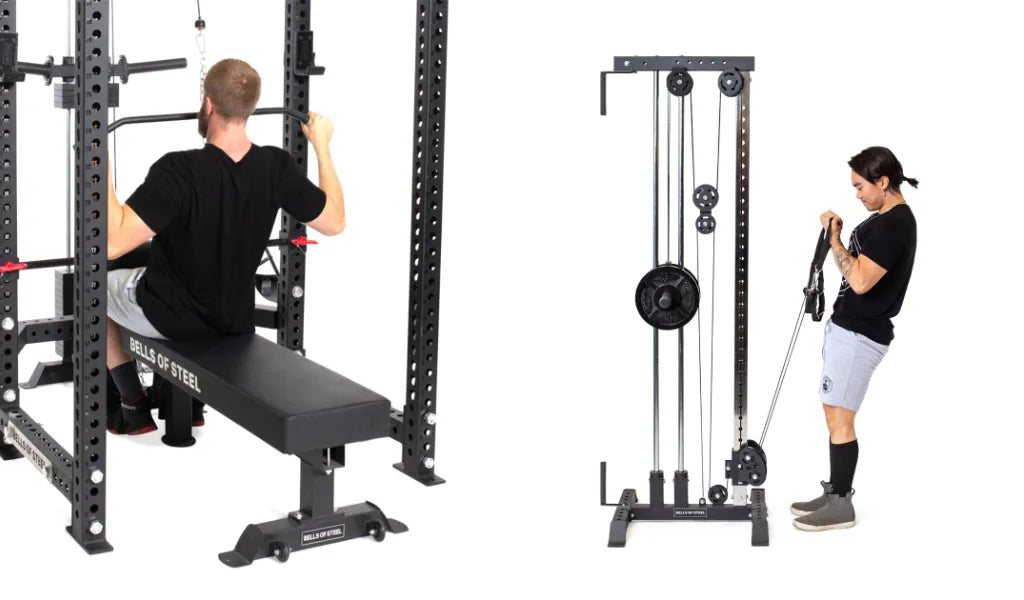Building your dream home gym is no small feat, and if you’re tight on space, the decisions get even trickier. One of the biggest dilemmas? Deciding between a power rack with a cable system and a standalone cable machine.
Do you go all-in on the multi-functional, space-saving rack setup or splurge on a dedicated, smooth-as-butter cable machine? It’s like choosing between pizza and burgers—both are awesome, but which one’s right for you?
In this article, we’ll help you break it down by covering the pros, cons, and sneaky little details you need to know before dropping some serious cash on either option. Whether you’re looking to save space, save money, or just save your sanity, we’ve got the lowdown to help you make the best decision for your home gym.
Power Rack with a Cable System: The Space-Saving Beast
Multi-Functionality at Its Finest
A power rack with a cable system is like that friend who’s great at everything. It gives you squats, bench presses, pull-ups, dips, and all your favorite cable exercises, all in one. For anyone trying to squeeze a full gym setup into the corner of their garage or basement, it’s a real lifesaver. The versatility is off the charts.
Pro: Multiple exercise options in a single, compact footprint.
Con: Can feel like a bit of a puzzle to assemble, but worth it.
Cost: A Wallet-Friendly Option
If you’ve ever priced out a standalone cable machine, you might’ve felt your wallet crying. A power rack with a cable system is a much more cost-effective option—especially if you’re already planning to buy a rack anyway. You’ll get nearly all the functionality of a standalone machine but without the heart-stopping price tag.
Pro: Combines two big pieces of equipment into one, saving you $$$.
Con: You’ll still shell out more than if you just bought a basic rack.
The Ultimate Space Saver
If you’ve got a tight space, a power rack with a cable system is basically the Tetris champion of home gym equipment. You’re getting multiple workout stations all in one neat package. Bells of Steel’s Kraken cable attachment is a prime example—it fits right between your rack’s uprights, offering maximum versatility without taking up more room than a pair of shoes (okay, maybe big shoes).
Pro: Space efficiency for days, especially with a smart add-on like the Kraken.
Con: If your rack is small, things might feel a bit cramped.
Standalone Cable Machine: The Smooth Operator
Laser-Focused on Cables
Let’s be real: if you’re all about cable movements (pulldowns, rows, curls), a dedicated cable machine is the Cadillac of the gym world. These machines offer a level of smoothness and adjustment options that power rack attachments can’t always match. They’re purpose-built for cable work, which means everything is streamlined for those specific exercises.
Pro: Smooth, dedicated operation that’s perfect for cable-focused exercises.
Con: You’re stuck with cables—and only cables.
The Price of Perfection
Standalone cable machines tend to come with a heftier price tag. You’re paying for that smooth pulley system, sleek design, and a built-in weight stack that makes adjusting your weight loads a breeze. While it’s definitely a high-end option, it’s not exactly budget-friendly. If you’re willing to invest in your cable work, it’s worth every penny.
Pro: Superior performance for cable exercises with a high-end feel.
Con: The price can be a real punch to the gut.
Space: The One Big Sacrifice
Standalone cable machines can be space hogs. These machines need room to stretch out, so if you’ve got a small gym area, you might have to play Tetris with your other equipment just to make it fit. It’s a perfect choice if you’ve got the real estate, but not ideal for cramped home gyms.
Pro: Amazing for dedicated cable workouts.
Con: Be prepared to sacrifice some serious floor space.
FAQs: Power Rack with Cable System vs. Standalone Cable Machine
Q: Which is better for small spaces?
A: If you’re working with a small space, go for a power rack with a cable system. You get all the versatility of a cable machine without hogging all your floor space.
Q: Which is more cost-effective?
A: A power rack with a cable system is generally more budget-friendly. You’re combining two big pieces of equipment into one, which helps cut down on overall costs.
Q: Do standalone cable machines offer smoother operation?
A: Yes! Standalone cable machines are built specifically for cable movements, so they usually have smoother pulley systems and are designed to handle more weight. Of course, there are always exceptions.
Q: Can you upgrade a power rack’s cable system?
A: Absolutely! Many power racks, like the ones from Bells of Steel, allow for upgrades. You can customize your setup with different attachments or heavier load options. The Kraken, for instance, is a modular add-on that turns your power rack into a cable beast.
Which One Should You Choose?
Here’s the bottom line: if you’re tight on space and looking for a budget-friendly, multi-purpose solution, a power rack with a cable system is the way to go. It’s perfect for those who want to maximize versatility without taking up too much room.
But, if you’re all about that smooth cable action and have the space (and cash) to spare, a standalone cable machine will give you the ultimate experience for cable exercises.
Still can’t decide? Check out the Bells of Steel Kraken for a space-saving, budget-friendly, and super versatile power rack cable attachment that’ll bring the best of both worlds to your home gym.



